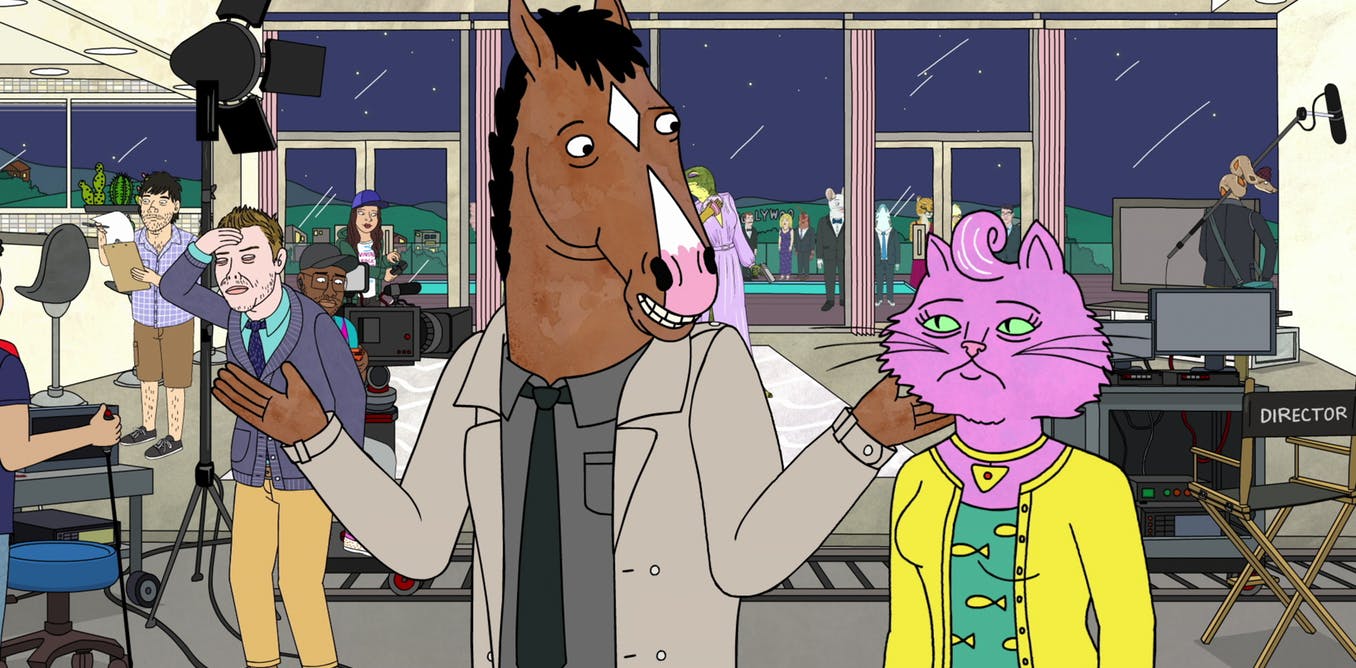By Paul Wells/The Conversation
For more than 100 years, across the world, in many diverse cultures, animation has featured talking animals. Indeed, the anthropomorphized cat, dog, mouse, ape, duck and rabbit have populated animation in a way that has defined much of its distinctive nature – by using animals to subvert social and cultural norms.
Netflix’s animated comedy-drama BoJack Horseman is another example of this. But BoJack, played by Will Arnett, is not a horse as playful companion like Maximus in Tangled or Bullseye in Toy Story. He is not an abused victim like Boxer in Animal Farm, and does not possess the lyrical equine beauty of Spirit: Stallion of the Cimarron. BoJack is literally a horse-man.
Like Bottom in Shakespeare’s A Midsummer Night’s Dream, he seems to have acquired a head that makes him think and feel differently. Not for BoJack the revelry of love, however. His thoughts are dominated by his own mortality, sense of failure, and deep misanthropy.
Few viewers will think of BoJack as a horse. Instead he is the mediator of bleak dysfunction, aided by the absurdist capacity for animation to create aesthetic distractions and exaggerate comic situations. Just as the old Road Runner cartoons represented meaningless repetition and relentless battles against the world without essential purpose or meaning, BoJack is the existential variant of this concept in the contemporary era.
BoJack’s perpetual hypocrisy, addictions and mistreatment of others may be funny, but they also serve as proof that he cannot change anything – that the world itself keeps repeating endless cycles of seemingly inhuman or inhumane models of existence.
made a mistake. bingewatched bojack horseman. cried pic.twitter.com/yyHxUCequ7
— soupery @sleep (@soupdraws) January 1, 2020
The combination of humankind and animal here echoes past adult-orientated animated series such as I Am Not An Animal, not just posing broad questions about what it is to be human but also offering challenging insights about humankind’s incapacity to fulfill its own potential. “We’re all terrible, so we’re all OK.”
From season one, there is BoJack’s own poignant realization that he may not ever be a “good person.” In season five, we meet Vance Waggoner, the vile embodiment of all things wrong with men and patriarchy in the #MeToo era. Across all 61 episodes so far, BoJack Horseman has explored all the ways in which humankind seeks to find its most acceptable moral and ethical identity in the face of its “real world” foibles, failings and feelings.

In a Truman Show-styled intervention in Season Five, BoJack is cast in Philbert, a TV detective show that more than resembles his own life. It serves as yet another knowing device that reveals how humankind has become indistinguishable from how it has been mediated – or indeed, how it uses its (social) media.
We’re All BoJack Horseman
This began from the show’s inception. A washed-up sitcom star from a 1990s show, Horsin’ Around, BoJack eyes a comeback by writing a revealing warts-and-all autobiography. In this alone, Bojack is a coruscating satire of Mister Ed the primetime American sitcom of the 1960s in which a talking palamino essentially outskills his human foil, Wilbur, for comic effect.
BoJack is also the mirror image of the children’s animation Marvin the Tap-Dancing Horse. The Netflix show is parodying the idea of the popular novelty act of distinction, but stressing how such carnival confections are forgotten legacies of the entertainment industry.
BoJack coats all such innocence with deep-rooted cynicism, playing out the view that humans are inherently selfish, revealed by the (bad) things they do, and rendered (self-)conscious only by the realization that they ought to be better.
when I find myself in times of trouble, bojack horseman comes to me, speaking words of wisdom pic.twitter.com/yK0Lz31ADi
— sally cinnamon 💫 (@discolento) January 2, 2020
The writers of BoJack Horseman have a highly sophisticated engagement with the contradictions and ambiguities of humanity. The program constantly stresses that the material world, for all its challenges and issues, needs to be understood as a resilient search for meaning and effect.
BoJack as a character becomes a site for this discussion. He is also a painful reminder of the old ironic joke about the mistreatment and perpetual misery of a circus elephant. “Run away,” say the elephant’s friends. “What?” he replies, “And miss out on a career in show business?”
All of this makes BoJack one of the most complex animated characters ever created. And the show itself demonstrates that animation – as it has shown in many forms globally in its long history – is a complex art form with serious purpose – even when it’s funny.
Paul Wells is the director of the Animation Academy at Loughborough University. This post is republished from The Conversation under a Creative Commons license.
–
See also:
* New Yorker: The Bleakness And Joy Of BoJack Horseman.
* Wikipedia:
“The show has consistently garnered widespread critical acclaim, with many critics calling BoJack Horseman a masterpiece. Vanity Fair crowned BoJack Horseman as the greatest television series of the 2010s, and other magazines like Rolling Stone and Time have also named BoJack Horseman as one of the best television series of the 2010s. The show is frequently cited as one of the best animated series of all time.”
–
Note: The final episodes of the final season arrive this month.
Just remembered we getting part 2 of Bojack Horseman at the end of the month!!!! pic.twitter.com/mGWhD6cXvm
— SuperShy Senpai.. (@Sinister_Shikwi) January 2, 2020
Posted on January 4, 2020


